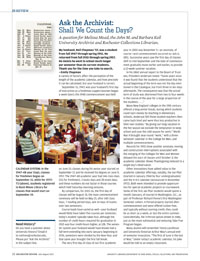In Review
 CALENDAR SYSTEM: In the 1947–48 year (top), classes for freshmen began on September 15, while for 1972–73 (above), students registered in Rush Rhees Library for classes that would start on September 19. (Photo: University Libraries/Department of Rare Books, Special Collections, and Preservation)
CALENDAR SYSTEM: In the 1947–48 year (top), classes for freshmen began on September 15, while for 1972–73 (above), students registered in Rush Rhees Library for classes that would start on September 19. (Photo: University Libraries/Department of Rare Books, Special Collections, and Preservation)My husband, Neil Chapman ’57, was a student from fall 1947 through spring 1951. He returned from fall 1955 through spring 1957. He insists he went to school much longer per semester than do current students. Thank you for the time you take to search. —Emily Chapman
A variety of factors affect the perception of the length of the academic calendar, and how precisely it can be calculated, but your husband is correct.
September 15, 1947, was your husband’s first day of instruction as a freshman (upperclassmen began a week later); the 1948 commencement was held on June 21; classes during his senior year started on September 17, and he received his degree on June 9, 1957. The 1947–48 academic year had 146 class days (151 for freshmen), 3 study days and 28 exam days, and these numbers do not factor in those courses which held Saturday morning sessions.
Need History?
Do you have a question about University history? Email it to rochrev@rochester.edu. Please put “Ask the Archivist” in the subject line.
By comparison, for 2015–16, the first day of classes will be August 31; the main commencement ceremony will be held on May 15, after 140 class days, 7 reading period days, and 14 days of exams over two semesters.
Course loads have varied as well—your husband would likely have taken five courses per semester; today’s student typically takes four, although the number of credit-hours required for graduation in 2015 was four credit-hours higher, at 128. The semester system your husband would have known had a fall term extending into early January; beginning in 1976, semesters were divided by the New Year, and that same year brought the first fall break.
The very first day of class of our first academic year in 1850 was November 5—an anomaly, of course—and commencement occurred on July 9, 1851. Successive years saw the first day of classes shift to mid-September and the date of commencement gradually move earlier and earlier, to provide a 12-week summer vacation.
In his 1860 annual report to the Board of Trustees, President Anderson noted: “Some years since it was found that the students understood that the actual beginning of the term was not the day mentioned in the Catalogue, but from three to ten days afterwards. The consequence was that the actual term of study was shortened from two to four weeks in the course of the year for a large proportion of the students . . . .”
Many New England colleges in the 19th century offered a long winter break, during which students could earn money by teaching in elementary schools. Anderson felt those student-teachers then came back tired and were thus less productive in their own studies: “By giving our long vacation in the hot season we exclude the temptation to keep school and save the cold season for work.” World War II brought year-round “work,” with a three-semester calendar in the College for Men, and multiple commencements.
Records for 1955 show another anomaly: moving and construction interruptions associated with the merging of the Colleges for Men and Women delayed the start of classes until October 3; the academic calendar shows Thanksgiving reduced to a single day’s observance.
Other innovations have added value to the academic calendar offerings, notably, the Jan Plan (started in January 1968 by four undergraduates) and the 4-4-X calendar (announced in November 1972). Both were intended to provide opportunities for special academic projects or coursework. Some of the first Jan Plan students would spend a month (January, of course) in Washington, D.C., as part of Professor Richard Fenno’s first Washington Semester cohort. X-Period projects started after commencement and were offered tuition-free, and typically without earning credit; they could be as short as a week, or last the entire summer. Coincidentally, the X-Period option ended in 1986, just as the more substantial and enduring Take Five Program began.
Many alumni will remember history professor and University historian Arthur May’s annual end-of-semester invocation, “The first of June is the last of May.” Under today’s academic calendar, his joke would be told to an empty classroom.

